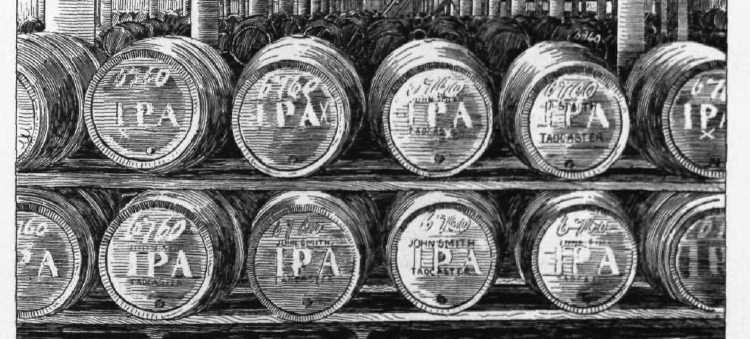With the triple IPA season upon us, we thought it would be a good time to revisit the origin story of the mighty IPA. What’s interesting is that the story of how IPAs got their start is somewhat hazy. The most well-known storyline appears to swing from muddled to exaggerated to outright wrong but it’s so well known it’s hard to sift through information and find out what is fact and what is a myth.
When Conventional Wisdom is Wrong
If you ask most people how the India Pale Ale style was invented, you will get something along these lines:
In the early 1800s, the East India Company was shipping supplies to British forces overseas, in India, on their way to fill their ships with spices, silks and other valuables from the Far East. The popular beers to drink at the time in Britain were stouts and porters, both of which were subpar beers to ship across the violent seas, and they often ended up stale, spoiled or infected. Also, the heavy beer wasn’t what was craved in the hot Indian climate, so even if it did arrive unspoiled, it was met with a middling reaction. George Hodgson’s Bow brewery decided that instead of sending a porter, they would try to send what was called an “October Beer.” This strong, pale beer was brewed at harvest time and loaded with just-picked hops to keep a fresh taste even when it was aged, sometimes for years. Apparently, the rough ocean journey matured this beer much like it would taste after 2 years aged, so when it arrived, it was at peak flavor. The resulting brew was a hoppy success and created a taste for India Pale Ale in India as well as back in Britain.
This paragraph came from one of our blogs about IPAs from a couple of years ago and features claims that come from sources like Business Insider and The Guardian. According to Zythophile and other sources, however, there are some myths in this version of the IPA origin story.
The first issue is that there appears to be no evidence that Hodgson’s brewery invented IPAs or that IPAs were “invented” at all. It’s more likely that this style of beer developed over time starting in 1709 when pale ales first began being sold in London. Over the years, these beers became known as “Pale ale prepared for the India Market” because of their popularity over there and then shortened to India Pale Ale. Hodgson was definitely the most well-known exporter of pale ale to India in the early 1800s but the pale ale that Hodgson was shipping to India wasn’t termed India Pale Ale until 40 years after he started exporting the beer.
The second myth in this storyline is that the ale being shipped to India was not primarily consumed by British forces. The troops preferred a homey porter to other styles of beer and it was readily available in India. In fact, porters and stout shipped just fine and were no more likely to spoil than pale ales. The pale ales exported to India were most often consumed by the upper and middle-class European expats who lived in India. They also found their way to military officers and civilians who were working for the East India Company at the time.
The third and perhaps the biggest myth is that strong IPAs were shipped over other styles because they were better preserved over the long journey. Not only did beer not need to be “strong” for the seaward journey, but IPAs were not really strong at the time anyway, usually around 6%. Sure many beers arrived spoiled or infected but that had nothing to do with the style of the beer and mostly had to do with the packaging and how the barrels were treated on the ship. While it is true that many breweries added extra hops to the beers being sent to warmer climates, this was commonplace by the 1760s.
In the early 1900s, IPAs fell into the British beer background; brewed occasionally but not really focused on. Then in the 1970s, IPAs were brought back with gusto by American craft brewers. They took the English IPA and amped up the hops, the alcohol content and reduced the amount of malts, creating a bold, hop-forward beer that is best consumed fresh.
Go West (Coast IPAs)
Brewers here on the West Coast have tapped into an even more amped up version of the American IPA, with even higher alcohol levels, more intense hoppy aromas and serious bitterness that is loved by many but also can be too extreme for some palates. West Coast IPAs are sometimes accused of lacking subtle flavors after the bracing hoppiness that slaps your palate with the first sip but this slap is exactly what many beer-drinkers love, and one of the reasons that IPAs are still one of the fastest growing segments of the craft beer market.
While some beer connoisseurs lament the rise of the IPA and its palate blowing characteristics, IPAs aren’t going anywhere anytime soon. They are still far and away the most popular style of craft beer and their sales continue to grow with IPA sales rising by 10.1% in the US over the last 12 months. Now, with the additional style of hazy IPA becoming mainstream we have more hoppy beers than ever to kick our palates into submission.

